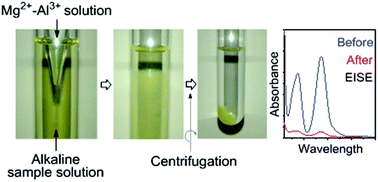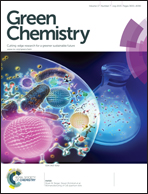New eco-friendly extraction of anionic analytes based on formation of layered double hydroxides†
Abstract
This work presents a new and green extraction method, named electrostatically induced stoichiometric extraction (EISE), where the stoichiometry of the present ions plays a significant role and can be tuned to effectively control the extraction. This method is based on the formation of layered double hydroxides (LDHs) that can enable the extraction of anionic analytes simultaneously as a result of the electrostatic induction. To prove the concept, magnesium (Mg2+) and aluminium (Al3+) ions were used as representatives of divalent and trivalent metal cations, respectively, as required to form the base of the LDH structure, while hexavalent chromium (Cr6+), present as chromate (CrO42−), was chosen as a model anionic analyte. The formation of a sorbent, LHD, and the extraction of the chromate ion were performed simultaneously by the introduction of a mixed solution of Mg2+ and Al3+ into an alkaline sample solution. The extracted chromate ion was then directly quantified by spectrophotometry. The applicability of this method was successfully demonstrated by the determination of the chromate ion in real water samples. The enrichment factor (EF) was 10 in a 10 mL sample solution. The linearity in the range of 50–1000 ng mL−1 with a limit of detection (LOD) of 22 ng mL−1 and reasonable recoveries were obtained. The EISE is superior to the other sorbent-based extraction methods since it is simple, rapid and able to eliminate the synthesis step of the sorbent. In addition, as this method does not use an organic solvent, it can be considered to be a green extraction method.


 Please wait while we load your content...
Please wait while we load your content...